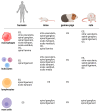Mammalian Inner Ear-Resident Immune Cells-A Scoping Review
- PMID: 39329712
- PMCID: PMC11430779
- DOI: 10.3390/cells13181528
Mammalian Inner Ear-Resident Immune Cells-A Scoping Review
Abstract
Background: Several studies have demonstrated the presence of resident immune cells in the healthy inner ear.
Aim: This scoping review aimed to systematize this knowledge by collecting the data on resident immune cells in the inner ear of different species under steady-state conditions.
Methods: The databases PubMed, MEDLINE (Ovid), CINAHL (EBSCO), and LIVIVO were used to identify articles. Systematic reviews, experimental studies, and clinical data in English and German were included without time limitations.
Results: The search yielded 49 eligible articles published between 1979 and 2022. Resident immune cells, including macrophages, lymphocytes, leukocytes, and mast cells, have been observed in various mammalian inner ear structures under steady-state conditions. However, the physiological function of these cells in the healthy cochlea remains unclear, providing an opportunity for basic research in inner ear biology.
Conclusions: This review highlights the need for further investigation into the role of these cells, which is crucial for advancing the development of therapeutic methods for treating inner ear disorders, potentially transforming the field of otolaryngology and immunology.
Keywords: inner ear; inner ear homeostasis; lymphocytes; macrophages; mast cells; steady-state tissues.
Conflict of interest statement
The authors declare no conflicts of interest.
Figures



Similar articles
-
The Human Endolymphatic Sac and Inner Ear Immunity: Macrophage Interaction and Molecular Expression.Front Immunol. 2019 Feb 1;9:3181. doi: 10.3389/fimmu.2018.03181. eCollection 2018. Front Immunol. 2019. PMID: 30774637 Free PMC article.
-
Role of adhesion molecules for the immunological defense of the inner ear.ORL J Otorhinolaryngol Relat Spec. 1995 Jan-Feb;57(1):10-4. doi: 10.1159/000276697. ORL J Otorhinolaryngol Relat Spec. 1995. PMID: 7700603
-
Csf1 Signaling Regulates Maintenance of Resident Macrophages and Bone Formation in the Mouse Cochlea.Front Neurol. 2019 Nov 21;10:1244. doi: 10.3389/fneur.2019.01244. eCollection 2019. Front Neurol. 2019. PMID: 31824413 Free PMC article.
-
Inner ear immunity.Hear Res. 2022 Jun;419:108518. doi: 10.1016/j.heares.2022.108518. Epub 2022 May 11. Hear Res. 2022. PMID: 35584985 Review.
-
Fundamental immune mechanisms of the brain and inner ear.Otolaryngol Head Neck Surg. 1995 Jun;112(6):639-53. doi: 10.1016/s0194-5998(95)70170-2. Otolaryngol Head Neck Surg. 1995. PMID: 7777346 Review.
References
Publication types
MeSH terms
LinkOut - more resources
Full Text Sources

